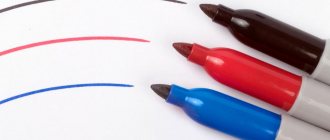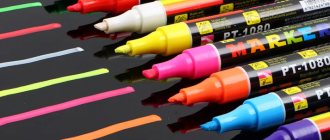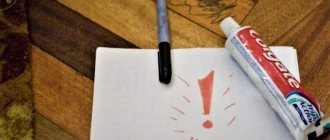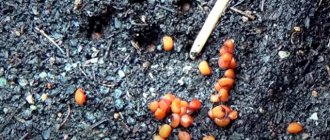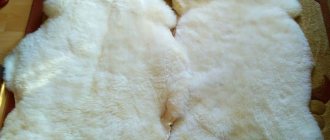How many times have your drawing or writing been interrupted by the dry, rough sound of a “dead” marker? If you think your marker has ended prematurely, fear not—dead markers can usually be brought back to life (temporarily, at least) using one of a few simple methods. Whether you use water-based markers, erasable markers, or even permanent markers, the solution to dry markers is often as simple as soaking the markers for a few minutes.
There can never be too many markers for children. They draw with them all day long and turn to their parents for help when they stop writing. What to do when you don’t have time to buy new markers, but your child asks to draw? Try to restore them! How, you ask? This article will help you understand this issue and return your baby’s smile.
Children's markers in most cases are water-based. They are much safer than other colored markers. But they are also found based on alcohol. Let's look at ways to restore these two components.
Look closely at the packaging to determine the type of dried markers. Only then begin recovery.
Before taking drastic measures, try the following option for restoring felt-tip pens. Using pliers, pull out the rod. Inside the marker there is a base that saturates the felt-tip pen with color. Turn it over and push the end back into place. If this doesn't help, then try the following tips.
Water-based markers
You can return bright colors to markers using clean water. Prepare a container for work by pouring one glass of warm water into it. You can also use cold liquid to restore felt-tip pens. But ink dissolves much faster in hot water.
Remove the caps from the markers and dip the tips into the water. Make sure they are completely immersed in liquid. Leave them in this position for 5 minutes.
Pull the markers out of the water. Wait for the water to drain, then transfer them to a dry cloth. There should be no moisture remaining on the tip of the felt-tip pen. Check this every hour - try writing with a felt-tip pen on paper. If there are no water stains along the colored line, then the marker is suitable for drawing.
To prevent markers from drying out quickly, be sure to put the caps on after use. If your child has lost them, tie a piece of the bag around the tip of the marker. Secure its edges with a rubber band.
How can I refill a whiteboard marker?
Restoring permanent markers
Modern manufacturers add isopropyl alcohol or acetone inside the rod.
Therefore, you can use alcohol or nail polish remover as a dressing. Water is not suitable for restoring permanent markers
.
Interesting materials:
How to obtain an EDS for IP registration? How to receive an EDS by email? How to obtain an EDS for a non-resident? How to obtain digital signature online step by step instructions? How to get f9 in MFC? How to receive a federal supplement to your pension? How to get a federal hunting license? How to get Form 9 on the government services website? How to get the YouTube 2022 tick? How to obtain hydrogen gas?
Types of markers and ways to “reanimate” them
A marker (from the English mark - mark), or as it was previously called - a "Magic Marker" pen - is a tool for writing and drawing with paint. The marker has another common name - felt-tip pen, which is a thinner prototype of the marker. The marker was invented at the beginning of the 20th century; at that time it vaguely resembled a modern marker; it consisted of a pen and felt filled with ink. After this discovery, the marker was modernized over the course of half a century, and in 1953 mass sales of markers began, which quickly became popular and conquered the market.
Today, markers are distinguished by composition and purpose. According to the composition they are distinguished:
- Alcohol. Alcohol markers are the most popular. They can be used to apply both translucent tones and dense, opaque ones. When applied to a surface, the alcohol evaporates quickly, so the color appears almost immediately in its final form. An image made with an alcohol marker is water-resistant and can only be washed off with alcohol. They are used to apply inscriptions and designs on paper, plastic, iron, wood and other materials.
- Water based. Water-based markers have a wide range and color transparency. The main difference is that the color layer, after drying, is not dissolved by the subsequent layer. Mixing colors and smooth transitions from one to another are impossible in this case. Water-based markers use up ink faster. The main use of water markers is working on paper and cardboard.
- Acrylic. They have dense, opaque colors. The peculiarity of these markers is that before the paint dries, you can create transitions and smoothly mix colors. After drying, a durable film is created that is not affected by water. Their main difference is the ability to apply an image to almost any surface. Acrylic-based markers are most widely used for exterior decorative work.
By purpose they are distinguished:
- General use. These are water- or alcohol-based markers that are used in almost all industries. These also include permanent markers, which leave a deep mark that remains on the surface for a long time. Their traces are not affected by moisture and are difficult to erase, except with alcohol or special means. They are usually used to apply inscriptions and images on any surface: wood, metal, plastic, paper and others.
- Text. Accordingly, they are designed to work with text, or rather to highlight important points in the text, therefore this type of markers is called a text highlighter. They have a translucent base that allows text to stand out.
- Artistic. They are used by artists, decorators and designers in their work. They are a modern alternative to paints, have bright, saturated colors, and can also be shaded (to create a smooth transition) while the marker layer is still wet. Once dry, the markers are not washed off with water.
- Professional. This group includes markers created for a specific area of production. For example, markers that can withstand high temperatures, markers for marking in hard-to-reach places and others.
- Automotive. These markers mask scratches on a car due to the fact that they leave a thick layer of paint that blends with the color of the car. They are usually made on an enamel base.
The shelf life of markers is approximately 2-3 years, after which they dry out and color saturation sharply decreases.
We know 5 ways to revive a marker and extend its service life:
Method 1: Store markers horizontally so that the base of the felt-tip pen is evenly distributed along the entire length of the refill.
Method 2. If you store markers in a stationery cup, turn them over at least once a week.
Method 3. This method is suitable for “revitalizing” a water-based marker. Pour 100-150 ml of hot or warm water into a bowl, place the markers in the water with the tips down, wait 5-6 minutes, then dry the markers for 10-20 minutes and close the cap.
Method 4: A water-based marker can be “revitalized” with vinegar. To do this, drop a few (1-2) drops of transparent 9% vinegar onto the tip of the marker and dry it for 3-5 minutes, close the cap.
Method 5. This method is suitable for “revitalizing” an alcohol marker. Pour 30-50 ml of alcohol into a bowl, place the markers in the alcohol with the tips down, wait 1-3 minutes. Then dry it for 1-2 days, tip up.
Markers, highlighters, felt-tip pens and other writing materials can be purchased in the Profupakovka online store, in the stationery section.
How to refill a marker or Two simple ways to restore an old, dried out marker
How to refill a marker or Two simple ways to restore an old, dried out marker.
Any craftsman uses a felt-tip pen, but not everyone knows that the name of this tool comes from the name of the company of the same name, Flo-Master, which first launched such a product on the market. Since that time, people have had a new problem: “How to refill a marker, how to restore a dry one?”
As far as I remember from my childhood, previously almost any felt-tip pen (marker) could be opened, refilled and used without much effort. It even seems to me that the first “eternal brushes” were made for reusable use.
But now manufacturers are apparently overcome by greed and they tightly seal the body of the felt-tip pen and force us to become more sophisticated and invent different ways of restoration and refueling.
I will describe the two methods that I use, and you choose which one suits you best in your case.
So, method One (urgent and reliable).
- We try to pull out the rear plug manually or with pliers (if it exists at all or is not sealed).
If this cannot be done, then we drill a hole in the rear plug of the marker that we are going to restore. I do not recommend burning, as there may be flammable vapors of alcohol (solvent) there.
- Then, using a regular syringe with a needle, we take a little alcohol (cologne, perfume or any liquid containing alcohol), insert the needle in through the hole and release it little by little.
Don’t try to fill it too much, otherwise it will start to leak.
- We seal the hole (not hot, but so that the plastic melts) with a soldering iron, seal it with some kind of “plug” or tighten it with a screw. It all depends on the diameter of the hole.
For example: I restored my first marker by simply screwing a roofing screw into the end, then unscrewing it, spraying several times from a bottle of perfume and screwing it back. It still works (for several years now), but it writes a little “transparently”. Attaching photo.
Tuned refilled marker and inscription made by him
Method Two, for the lazy (but time-consuming).
- Pour a little filling liquid (alcohol, etc.) into the plug or cap and place a marker there with the “sting” facing down. Let it sit until the liquid is absorbed into the marker.
- Very important: do not put markers of different colors in the same lid, otherwise they may “exchange experiences.”
The only significant disadvantage of this method is that it does not allow you to fully use the marker resource, and it requires more time than the previous method. But for this you don’t need to disassemble anything and everything will be done without “surgical intervention”.
I hope everyone understood that I described this experience specifically for permanent markers. What distinguishes them from “water-soluble” markers is their stronger, specific smell.
In principle, the procedure is no different, we just use alcohol as a solvent for some, and ordinary water for others.
“Ice cream for the children, flowers for the woman. And be careful not to mix it up..."
I hope I described everything clearly, but if you have any questions (objections, suggestions), you can ask them in the comments.
Source: sam0del.ru
If it contains alcohol
Alcohol markers are rarely used by children, as they have a strong, unpleasant odor and can be hazardous to their health. In addition, they dry out quickly enough and are much more expensive than water-based ones. Alcohol-based felt-tip pens and markers are used in offices, industry or creativity. As a rule, the inscription made with such a felt-tip pen can be removed using an alcohol-containing solution.
We prepare a special dressing from simple ingredients
There are two ways to prepare a special dressing. So, what to refill the marker with?
For the first option, you will need: water, gouache, ink, powder, PVA glue, two tablespoons of sugar and a half-liter container.
First you need to fill the vessel one third with water. Next, gouache and powder are added to the water. Beat thoroughly and slowly add mascara. To prevent the dressing from turning out too black, it is important not to overdo it. After this, you need to add 20 drops of glue to the mixture and mix the mass thoroughly again. Sugar is added to achieve homogeneity. The mixture is whipped again - the dressing is ready!
For the second method you will need: two containers, a ballpoint and gel pen, a touch-corrector, nail polish, acetone, hairspray, brilliant green.
First you need to pour the bar corrector into one container and then let it dry. Grind the dried mass into powder and pour into another container. Ink from a ballpoint pen and ink of the desired color from a gel pen are also added there.
Add brilliant green and nail polish of a suitable color to the resulting mass. All this is fixed with hairspray and mixed thoroughly. Next you need to add nail polish remover or acetone. That's all. The gas station is ready!
The important thing is that these refills are moisture resistant.
How do you know when it's time to refill the marker?
The first step is to check both tips of each marker to make sure they are wet with ink. The main sign of running out of marker for drawing is the streaks that a wide chisel pen can leave. These streaks are caused by insufficient ink inside the marker.
It is also not difficult to identify an almost empty marker by its brush tip. In this case, you will notice that the ink has difficulty reaching the very tip of the brush or you have to press hard on the pen to get a full fill.
Sometimes only one of the nibs of a double-ended sketch marker becomes dry, but the other one continues to draw perfectly. As a rule, in this case it is also worth refilling this marker as soon as possible, because soon the second pen will stop writing.
If over time you have to put in more and more effort to evenly color the areas on the paper and the color doesn’t “fit” in any way, then most likely it’s worth refilling the marker.
What is the difference between regular markers and sketching markers?
Sketching markers are professional analogues of children's felt-tip pens, but sketching markers have a much wider palette of shades, higher build quality of the body and nibs.
Interesting materials:
When to prune raspberries in autumn or spring? When to prune peonies in the fall? When to prune roses in autumn or spring? When to prune a plum tree in spring or autumn? When to prune currants in spring or autumn? When to prune grapes in autumn or spring? When to prune cherry trees in spring or autumn? When to trim roses in the fall and cover them? When do autumn honey mushrooms appear? When to water trees and shrubs in the fall?
Water markers
Almost all modern children's markers are water-based. This is done to provide bright, rich colors while still being safe for the youngest artists. In addition, such markers are easily washed off from clothes and any surfaces, do not have an unpleasant odor and can be stored for quite a long time even with open caps. A drawing made with such a felt-tip pen lasts a long time and does not fade in the sun. But, as you know, nothing lasts forever. Sooner or later, even such markers cease to please their owner.
Ready solution
If you do not dare to experiment, but at the same time do not want to buy new art supplies and are still wondering what to refill the marker with, we suggest you use a ready-made solution. The fact is that many manufacturers sell ready-made refills for markers. They are special inks of different shades and are supplied in convenient jars with a spout, and are also additionally equipped with a dispenser for more accurate measurement of the substance. This is a great solution for refillable markers.
What are good markers for drawing?
Rating TOP 9 sets of felt-tip pens
- Touch.
- Faber-Castell Connector.
- Faber-Castell Castle
- Centropen Textile (2739/6)
- Junland " Drawing
" (151416) - Maped "Jungle" (845421)
- Carioca Birello (41438)
- Carioca Perfume (42672)
Interesting materials:
How much fish can you catch in Belarus? What is the cure for fever for an adult? Which oil is rich in vitamin E? What oil should I use to moisturize my skin? What kind of oil to pour into a two-stroke scooter engine? Which oil is suitable for very dry skin? Which oil is suitable for dry skin? Which oil is the most effective in the fight against wrinkles? What kind of oil should I pour into the Gazelle Next engine? What kind of oil should I put in my lawn mower engine?
Methods for refilling a felt-tip pen
To be completely honest, all of the above methods do not refill, but rather dissolve the dye already present in the felt-tip pen, that is, they actually help if the felt-tip pen has dried out. What to do when the dye runs out?
You can try adding printer ink to the refill or use various household dyes, such as brilliant green, manganese, etc. But remember that felt-tip pens filled in this way will not last you long. And their price is quite low and does not justify such efforts. All these methods are more suitable when it is not possible to purchase a new felt-tip pen at this very moment.
Additionally, some alcohol markers are not designed to be refilled. If you try to bring them back to life, you will simply fail. This information is usually indicated on the packaging. Most often these are expensive art markers or, on the contrary, cheap Chinese ones, in which all the dye instantly flows out.
The number of “refills” in any case will depend on how much dye was originally in the felt-tip pen. If the manufacturer immediately saved money, then such a felt-tip pen will not serve you for long, no matter how hard you try.
How to refill a set of water-based markers: a miracle product at hand!
Answer to the question: “What to refill water-based markers with?” lies in the question itself. Since water acts as a solvent, it means that dried paint can be “reanimated” with ordinary water. This is done in several ways.
Using water, you can return the ink to its original brightness.
- You can fill the felt rod, which is the dye reservoir, using a regular syringe filled with water. Having removed the cap from the end of the body, you should carefully introduce water into the center of the rod, preferably gradually, 10-15 drops at a time.
The main thing is not to overdo it: if there is more water than necessary, it will begin to flow through the tip and wash out the dye. As water is introduced, the felt rod will begin to lighten from the edge where the water is introduced. This is how it should be; this reaction indicates that the paint has begun to dissolve and flow to the tip. After refilling, you should leave the markers in a vertical position (writing end down), and after 3-4 hours, check the effectiveness of the procedure by comparing the color intensity with the control indicator, which must be done before refilling. If necessary, you can add a few more drops of water.
In principle, the methods described above are not refilling markers in the literal sense: rather, they are re-dissolving the dye remaining in the reservoir. To refill water-based markers, it is recommended to use water in combination with water-soluble dyes: ink, paint for cartridges, etc.
How to refill the marker? This question is asked by every person whose drawing is interrupted by the rough grinding sound of a dry felt-tip pen. There is absolutely no need to go to the store for a new package of markers, because there are many ways to bring old drawing accessories back to life. Thanks to them, you can restore permanent markers, as well as those that are made on a water basis.
What to do?
- First way. Pour alcohol into a marker cap or another small container and place the marker there. Leave it there for a while until it collects the required amount of liquid.
- Second way. Carefully drill or pierce a hole with a hot nail, through which pour a few drops of alcohol with a syringe. Then solder it or install a removable plug.
Attention! When using this method, do not use hot objects, as highly flammable alcohol vapors may collect under the lid. Simply heat a nail or any other sharp object slightly.
Before refilling the marker
– Be sure to take care to protect your desk or other work surface from ink. To do this, you can lay down rough paper or fabric.
– Make sure you select the correct ink shade for your specific marker. Typically, the color number on the refill bottle exactly matches the number on the body or cap of the marker.
– For convenience, it is worth preparing wet wipes containing alcohol or another alcohol-based product to clean your hands, marker or table from ink drops.
